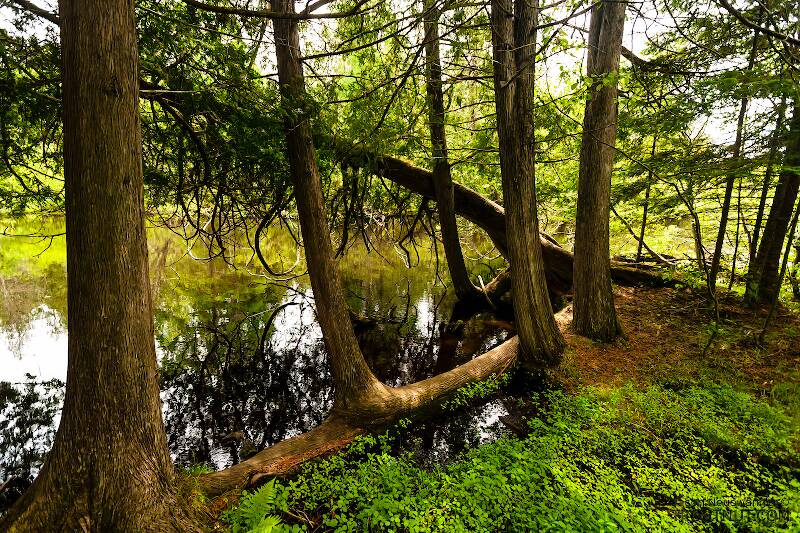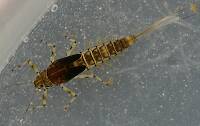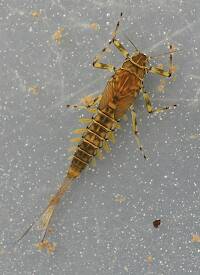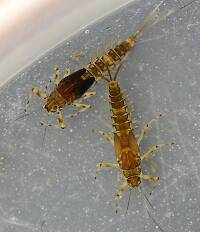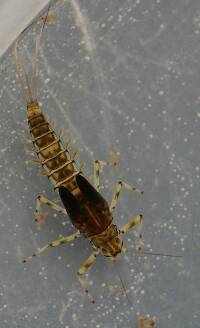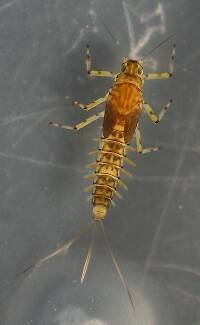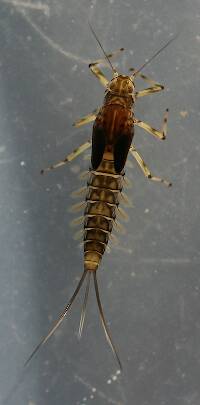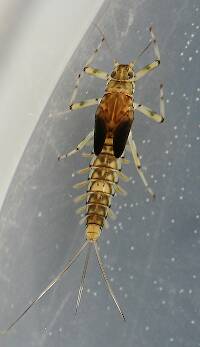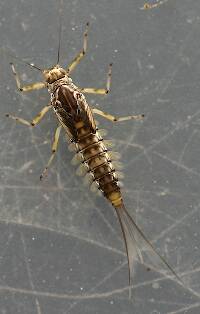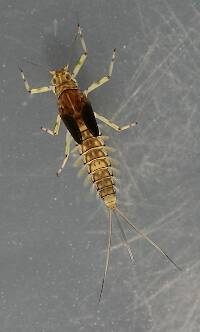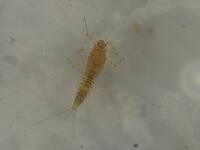
Blue-winged Olives
Baetis
Tiny Baetis mayflies are perhaps the most commonly encountered and imitated by anglers on all American trout streams due to their great abundance, widespread distribution, and trout-friendly emergence habits.
Featured on the forum

This is a striking caddis larva with an interesting color pattern on the head. Here are some characteristics I was able to see under the microscope, but could not easily expose for a picture:
- The prosternal horn is present.
- The mandible is clearly toothed, not formed into a uniform scraper blade.
- The seems to be only 2 major setae on the ventral edge of the hind femur.
- Chloride epithelia seem to be absent from the dorsal side of any abdominal segments.
Based on these characteristics and the ones more easily visible from the pictures, this seems to be Grammotaulius. The key's description of the case is spot-on: "Case cylindrical, made of longitudinally arranged sedge or similar leaves," as is the description of the markings on the head, "Dorsum of head light brownish yellow with numerous discrete, small, dark spots." The spot pattern on the head is a very good match to figure 19.312 of Merritt R.W., Cummins, K.W., and Berg, M.B. (2019). The species ID is based on Grammotaulius betteni being the only species of this genus known in Washington state.
- The prosternal horn is present.
- The mandible is clearly toothed, not formed into a uniform scraper blade.
- The seems to be only 2 major setae on the ventral edge of the hind femur.
- Chloride epithelia seem to be absent from the dorsal side of any abdominal segments.
Based on these characteristics and the ones more easily visible from the pictures, this seems to be Grammotaulius. The key's description of the case is spot-on: "Case cylindrical, made of longitudinally arranged sedge or similar leaves," as is the description of the markings on the head, "Dorsum of head light brownish yellow with numerous discrete, small, dark spots." The spot pattern on the head is a very good match to figure 19.312 of Merritt R.W., Cummins, K.W., and Berg, M.B. (2019). The species ID is based on Grammotaulius betteni being the only species of this genus known in Washington state.

Troutnut is a project started in 2003 by salmonid ecologist Jason "Troutnut" Neuswanger to help anglers and
fly tyers unabashedly embrace the entomological side of the sport. Learn more about Troutnut or
support the project for an enhanced experience here.
Lastchance on Feb 4, 2012February 4th, 2012, 3:48 am EST
If I'm not mistaken, the first baetis nymphs that appear in the spring in PA have a light olive abdomen and a dark olive thorax. Which species is this? They appear to be size 18s and 20s.
Bruce
Bruce
PaulRoberts on Feb 4, 2012February 4th, 2012, 4:35 am EST
The first to appear in NY (I was aware of, and if I remember correctly, AND if the name hasn't changed!) was tricaudatus. It's a #16/#18 (Mustad) as a dun. If the stream gives a second brood, the later summer ones are smaller.I've found tricaudatus here in CO Front Range streams too, and believe they are our first emergers. They are also #16/#18 as a dun.
Ah! Nymphs, you say... Spring Baetid nymphs run from a light golden olive to a dark brownish olive. I assume that the lighter ones, often smaller, are lesser developed tricaudatus (they don't all mature at exactly the same time, dependent on thermal units apparently), and some are likely immatures of other species. The largest ones (#18/#20 is a good ballpark) with the nearly black wing-buds are the ones about to emerge.
Ah! Nymphs, you say... Spring Baetid nymphs run from a light golden olive to a dark brownish olive. I assume that the lighter ones, often smaller, are lesser developed tricaudatus (they don't all mature at exactly the same time, dependent on thermal units apparently), and some are likely immatures of other species. The largest ones (#18/#20 is a good ballpark) with the nearly black wing-buds are the ones about to emerge.
Quick Reply
Related Discussions
Topic
Replies
Last Reply
0
Nov 6, 2020
by Troutnut
by Troutnut

